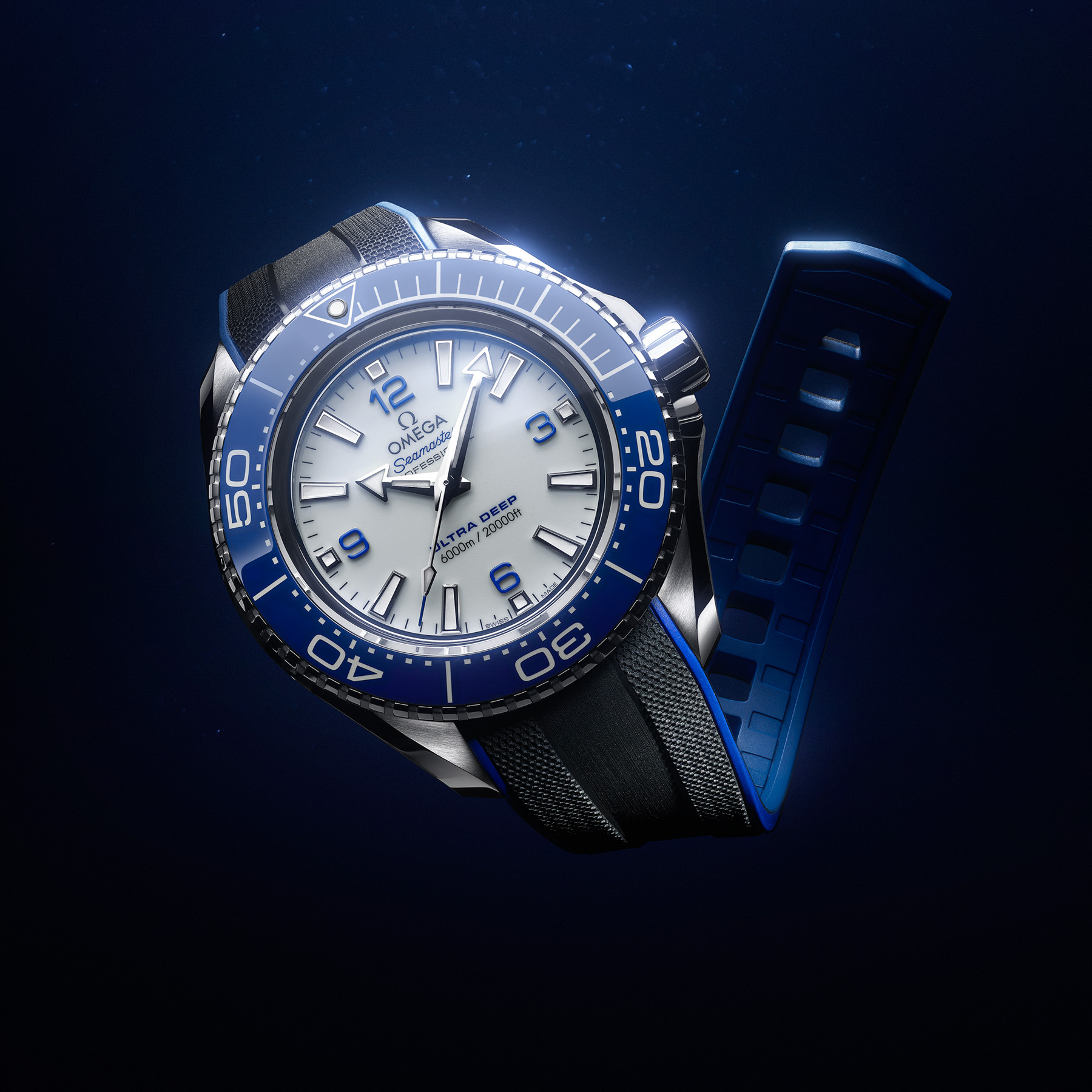 It was only a matter of time, right? After private equity investor-turned-ocean-explorer Victor Vescovo’s record-setting 2019 dive to Challenger Deep in the Mariana Trench, the prototype Omega Seamaster Ultra Deep Professional strapped to the robotic arm of his submersible is finally being made available in a slightly pared-back civilian variant. But it’s not just one watch — instead, we get an entirely new collection of super-burly Seamaster dive watches: three in stainless steel on newly sculpted bracelets, and one in titanium on a NATO strap made from recycled fishing nets, the latter of which most closely echoes the utility and aesthetics of the original prototype that made the record-breaking dive. Oh, and then it went on to make repeated dives with the submersible Limiting Factor in the summer months that followed, as Vescovo ferried fellow researchers, dignitaries, and even a former astronaut (Kathy Sullivan, who was the first woman to walk in space) to the deepest known location on the planet. No big deal.
It was only a matter of time, right? After private equity investor-turned-ocean-explorer Victor Vescovo’s record-setting 2019 dive to Challenger Deep in the Mariana Trench, the prototype Omega Seamaster Ultra Deep Professional strapped to the robotic arm of his submersible is finally being made available in a slightly pared-back civilian variant. But it’s not just one watch — instead, we get an entirely new collection of super-burly Seamaster dive watches: three in stainless steel on newly sculpted bracelets, and one in titanium on a NATO strap made from recycled fishing nets, the latter of which most closely echoes the utility and aesthetics of the original prototype that made the record-breaking dive. Oh, and then it went on to make repeated dives with the submersible Limiting Factor in the summer months that followed, as Vescovo ferried fellow researchers, dignitaries, and even a former astronaut (Kathy Sullivan, who was the first woman to walk in space) to the deepest known location on the planet. No big deal.
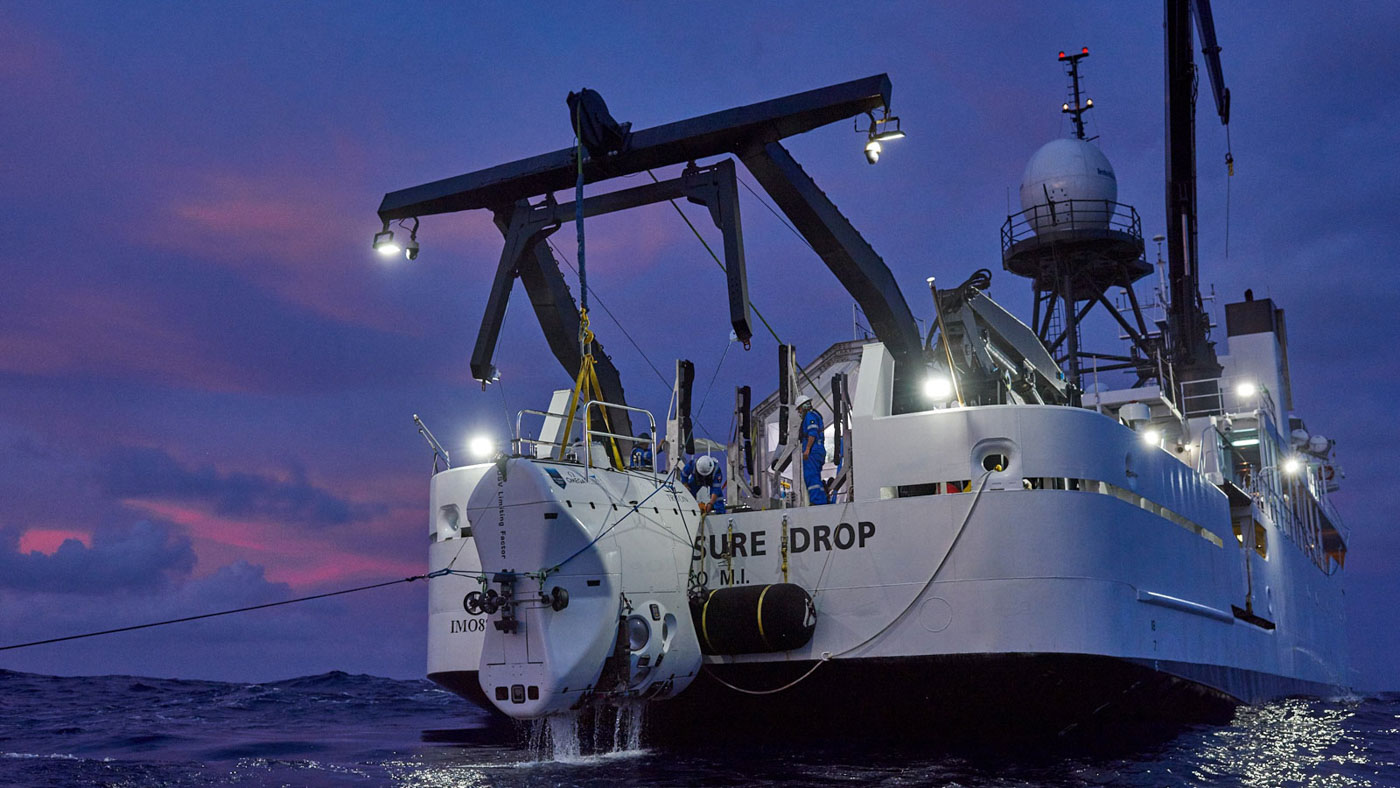
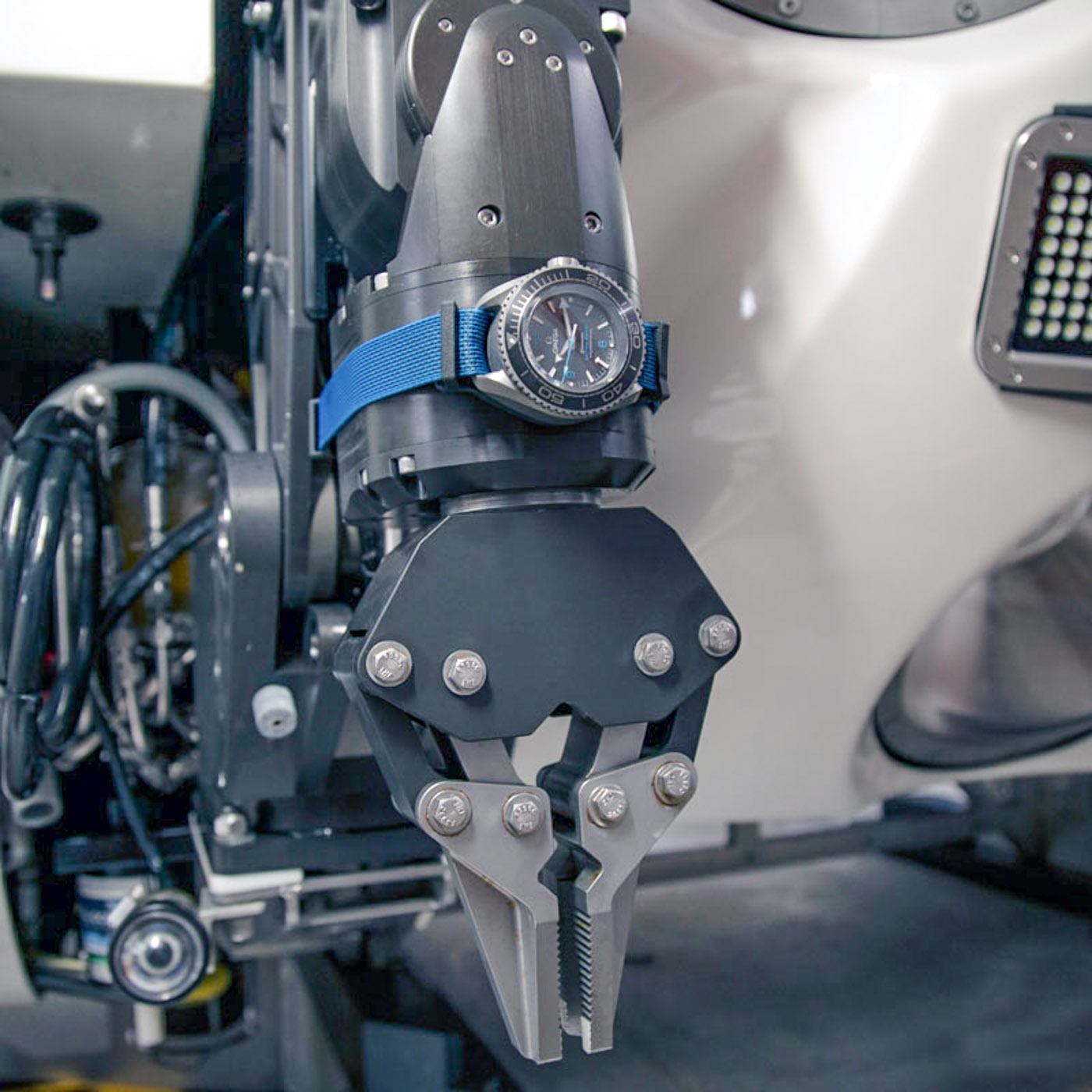 How deep is “Ultra Deep,” exactly? Well, Vescovo’s history-making dive to the southern end of the trench touched down at 10,928 meters, or 35,853 feet (a newly discovered slope in the trench some 30 meters deeper than the previously established 2012 record by James Cameron, whose own submersible had a special Rolex Deepsea Challenger affixed to its exterior), though that Seamaster prototype was actually tested to a mind-boggling 15,000 meters of water resistance, to accommodate for the 25% safety margin required for the nearly 11,000-meter journey. Naturally, that watch was a uniquely unapologetic beast — 54mm in diameter, and nearly 30mm-thick, utilizing a porthole-style blueprint, specially forged grade 5 titanium, and Omega’s proprietary LiquidMetal technology, which reduced the design’s dependence on traditional seals and married the sapphire crystal to the case body with an impregnable bond.
How deep is “Ultra Deep,” exactly? Well, Vescovo’s history-making dive to the southern end of the trench touched down at 10,928 meters, or 35,853 feet (a newly discovered slope in the trench some 30 meters deeper than the previously established 2012 record by James Cameron, whose own submersible had a special Rolex Deepsea Challenger affixed to its exterior), though that Seamaster prototype was actually tested to a mind-boggling 15,000 meters of water resistance, to accommodate for the 25% safety margin required for the nearly 11,000-meter journey. Naturally, that watch was a uniquely unapologetic beast — 54mm in diameter, and nearly 30mm-thick, utilizing a porthole-style blueprint, specially forged grade 5 titanium, and Omega’s proprietary LiquidMetal technology, which reduced the design’s dependence on traditional seals and married the sapphire crystal to the case body with an impregnable bond.
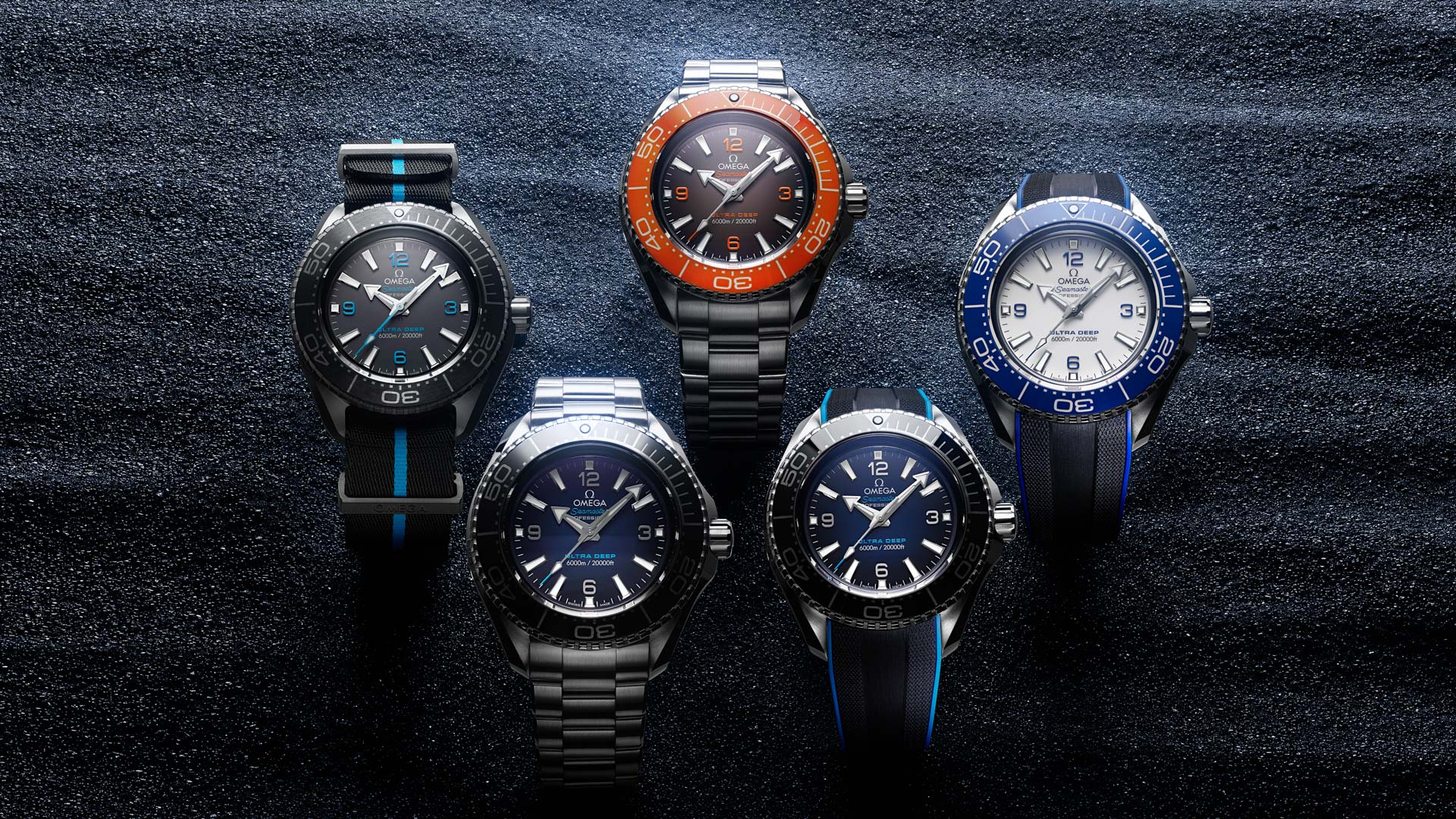
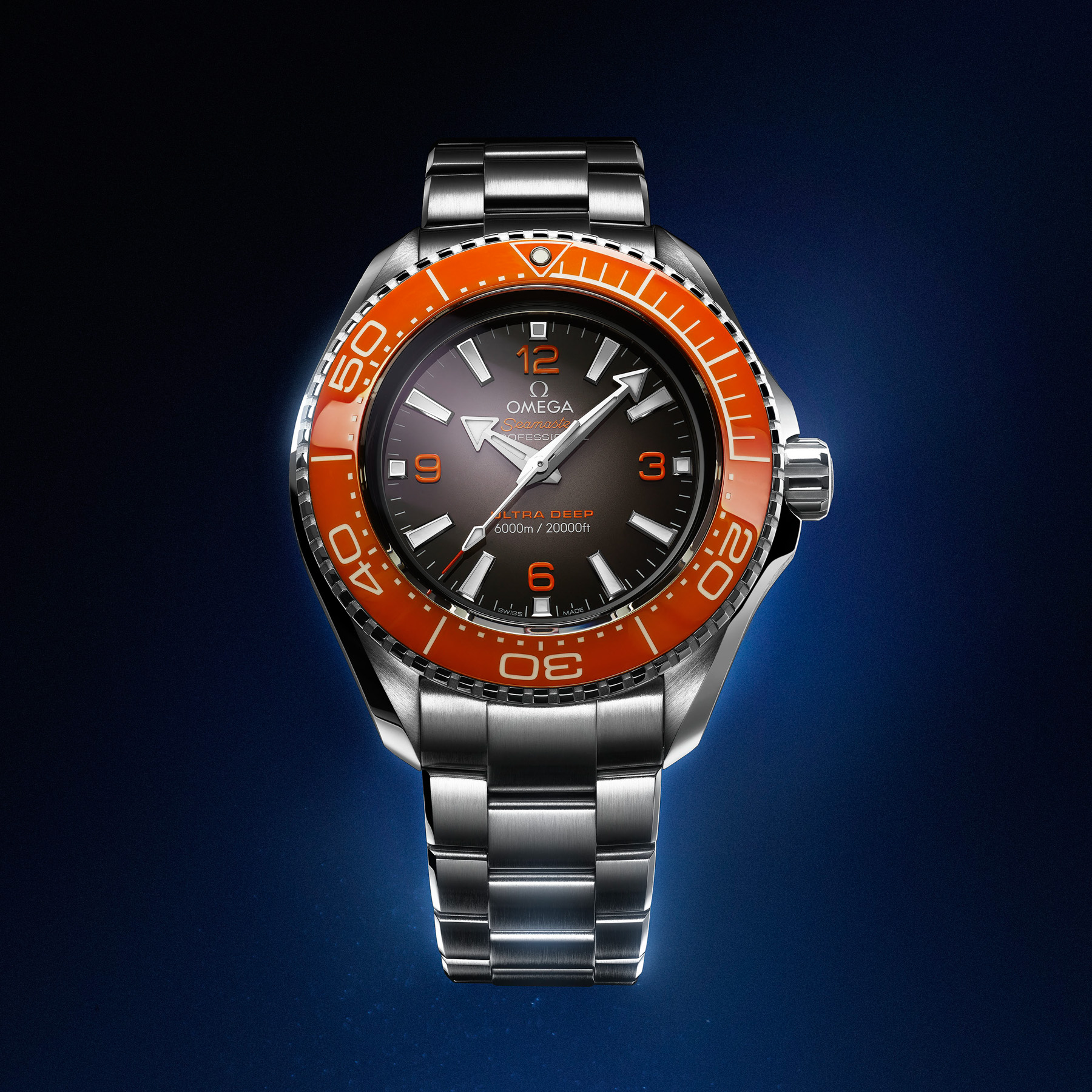 So, while the civilian Ultra Deep doesn’t maintain the mind-boggling 15,000 meters of water resistance from the prototype, it still achieves the practicality-defying figure of 6,000 meters, putting it head and shoulders above similar super-deep divers like the Breitling Avenger II (4,000 meters), the Rolex Deep Sea-Dweller “James Cameron” (3,900 meters), the IWC Aquatimer 3292 (2,000 meters), as well as its own Seamaster stablemate, the Ploprof, which tops out at 1,200 meters, though it impressively does so with an exhibition caseback. Even the mighty Sinn UX with its innovative oil-filled dial and special quartz movement maxes out at 5,000 meters. Granted, these are largely inconsequential figures for anyone not named Victor Vescovo or James Cameron, particularly when you consider for a moment that a recreational diver rarely encounters depths in excess of 30 or 40 meters, or that even the world’s bravest closed-circuit divers ever dare to venture below 200 meters. But when the world of watches is content to split hairs over lightness, thinness, accuracy, machine tolerance for screw threads, or a whole wealth of other trite metrics, you already know practicality isn’t the aim here. That’s because at the end of the day, our obsession with the superlative will never go fully satiated, and if you’ve spent enough time in the rabbit hole, you already know that’s totally ok.
So, while the civilian Ultra Deep doesn’t maintain the mind-boggling 15,000 meters of water resistance from the prototype, it still achieves the practicality-defying figure of 6,000 meters, putting it head and shoulders above similar super-deep divers like the Breitling Avenger II (4,000 meters), the Rolex Deep Sea-Dweller “James Cameron” (3,900 meters), the IWC Aquatimer 3292 (2,000 meters), as well as its own Seamaster stablemate, the Ploprof, which tops out at 1,200 meters, though it impressively does so with an exhibition caseback. Even the mighty Sinn UX with its innovative oil-filled dial and special quartz movement maxes out at 5,000 meters. Granted, these are largely inconsequential figures for anyone not named Victor Vescovo or James Cameron, particularly when you consider for a moment that a recreational diver rarely encounters depths in excess of 30 or 40 meters, or that even the world’s bravest closed-circuit divers ever dare to venture below 200 meters. But when the world of watches is content to split hairs over lightness, thinness, accuracy, machine tolerance for screw threads, or a whole wealth of other trite metrics, you already know practicality isn’t the aim here. That’s because at the end of the day, our obsession with the superlative will never go fully satiated, and if you’ve spent enough time in the rabbit hole, you already know that’s totally ok.

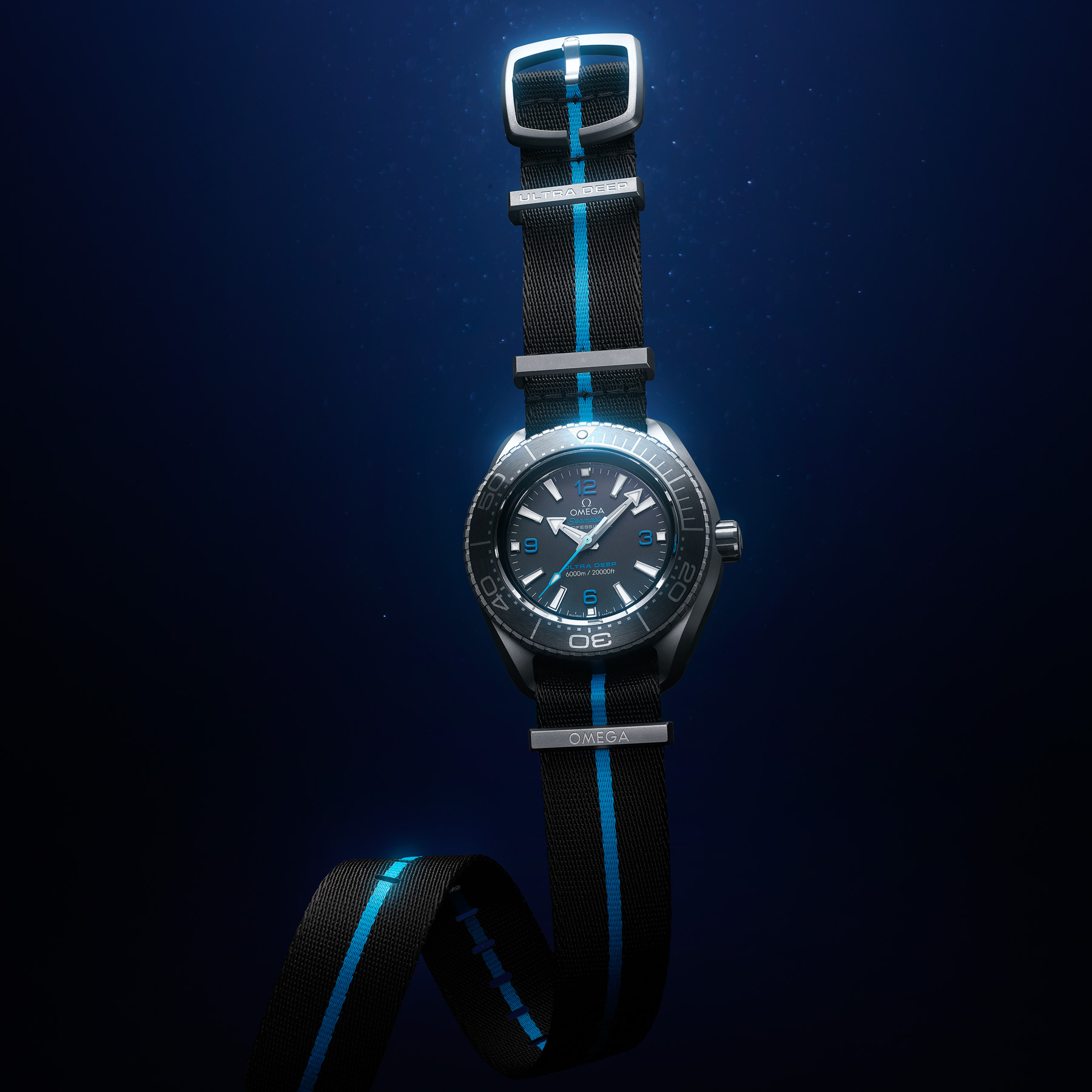 The new ISO 6425-certified civilian Ultra Deep was ocean-tested in the Marana Trench to a depth of 6,269 meters in 2021, with the aim of maintaining the real-world palmares of its predecessor. It also retains the unapologetic purpose-first silhouette of the prototype but is markedly more wearable at 45mm by 18.2mm-thick — still big, for sure, but well within the realm of other “large-ish” tool watches, like the aforementioned 44mm Rolex Deep Sea-Dweller, any number of 47mm Panerai Submersibles (ref. PAM1389 comes to mind), or Omega’s own 45mm ceramic Seamaster Deep Black introduced back in 2016. And while it does make a major concession in overall water resistance, it does so in the name of actual wearability and long-term serviceability (gone is that LiquidMetal interface between crystal and case, which wasn’t exactly a tenable long-term solution for even a competent watchmaker). Longtime critics of the manual helium release valve that’s traditionally occupied its position at the 10:00 position on the Planet Ocean case will have something to rejoice over, as the Ultra Deep is certified for saturation diving, and has no need for an HR valve of any kind.
The new ISO 6425-certified civilian Ultra Deep was ocean-tested in the Marana Trench to a depth of 6,269 meters in 2021, with the aim of maintaining the real-world palmares of its predecessor. It also retains the unapologetic purpose-first silhouette of the prototype but is markedly more wearable at 45mm by 18.2mm-thick — still big, for sure, but well within the realm of other “large-ish” tool watches, like the aforementioned 44mm Rolex Deep Sea-Dweller, any number of 47mm Panerai Submersibles (ref. PAM1389 comes to mind), or Omega’s own 45mm ceramic Seamaster Deep Black introduced back in 2016. And while it does make a major concession in overall water resistance, it does so in the name of actual wearability and long-term serviceability (gone is that LiquidMetal interface between crystal and case, which wasn’t exactly a tenable long-term solution for even a competent watchmaker). Longtime critics of the manual helium release valve that’s traditionally occupied its position at the 10:00 position on the Planet Ocean case will have something to rejoice over, as the Ultra Deep is certified for saturation diving, and has no need for an HR valve of any kind.
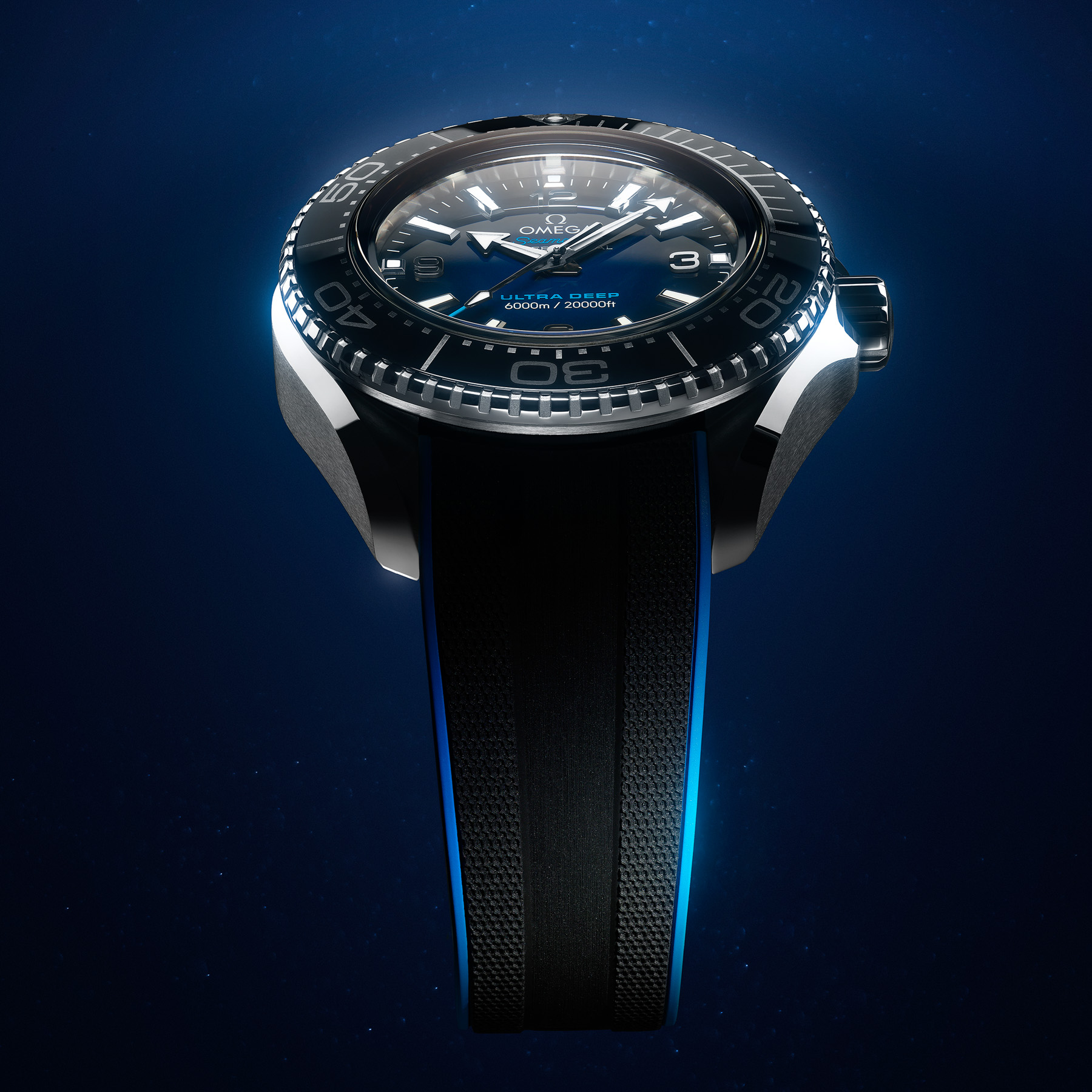
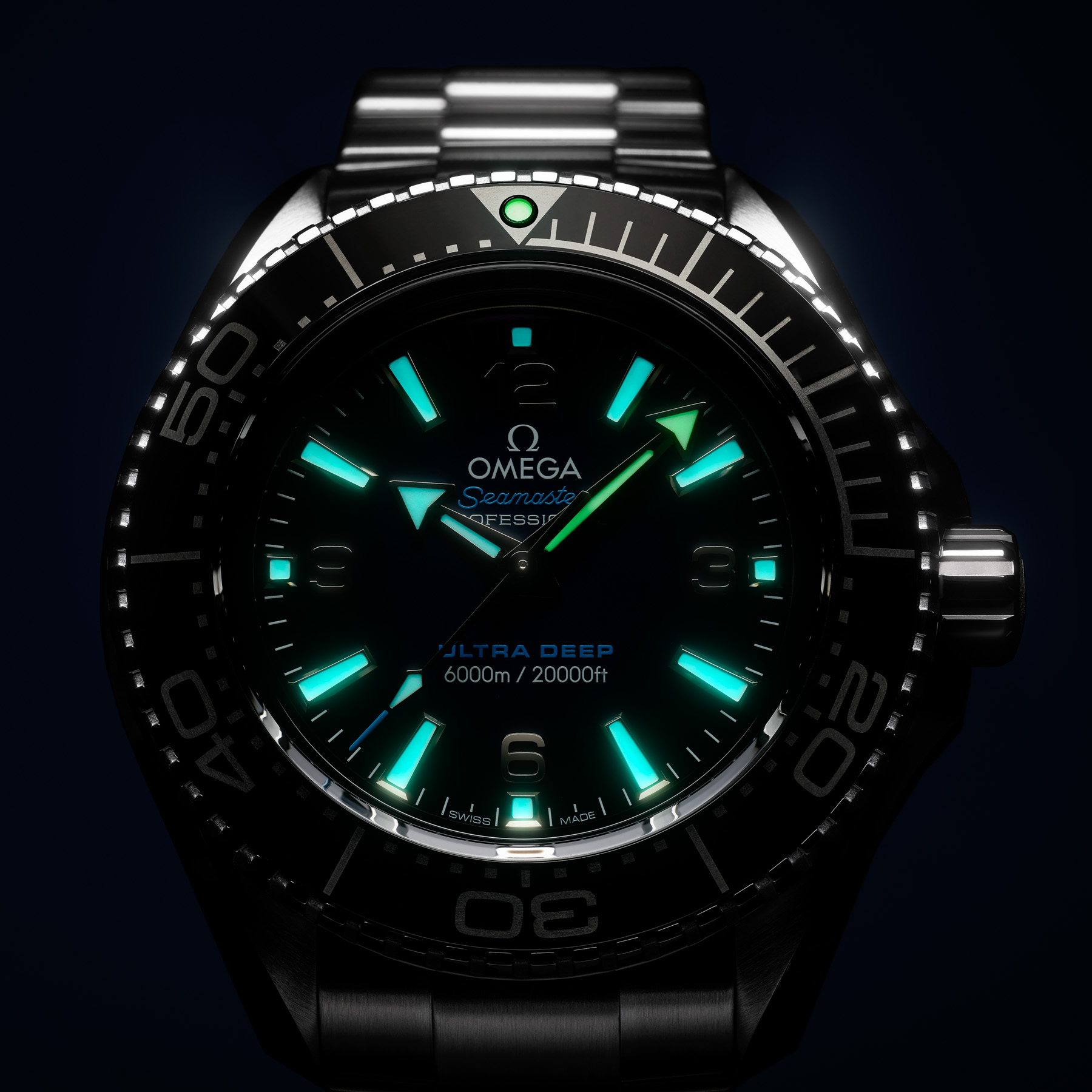 Wearability is particularly key here, thanks to the Planet Ocean’s signature barrel case shape, reduced dial aperture, and short, lyre lugs which reduce the watch’s stance across the wrist. Speaking of lugs, one of the prototype Ultra Deep’s defining features, besides its hockey puck-esque thickness, of course, was its sweeping Manta Lugs — integrated, wing-like tabs designed to accept a NATO-style pass-through strap. It’s an elegant, aesthetically pleasing alternative to fixed spring bars or the seamless machined lugs found on the recent Tudor FXD, and it’s a design signature that returns on the civilian Ultra Deep but only on the titanium variant. The steel references take traditional spring bars and a newly designed bracelet with polished sides and Omega’s now-standard rack-and-pusher adjusting clasp.
Wearability is particularly key here, thanks to the Planet Ocean’s signature barrel case shape, reduced dial aperture, and short, lyre lugs which reduce the watch’s stance across the wrist. Speaking of lugs, one of the prototype Ultra Deep’s defining features, besides its hockey puck-esque thickness, of course, was its sweeping Manta Lugs — integrated, wing-like tabs designed to accept a NATO-style pass-through strap. It’s an elegant, aesthetically pleasing alternative to fixed spring bars or the seamless machined lugs found on the recent Tudor FXD, and it’s a design signature that returns on the civilian Ultra Deep but only on the titanium variant. The steel references take traditional spring bars and a newly designed bracelet with polished sides and Omega’s now-standard rack-and-pusher adjusting clasp.
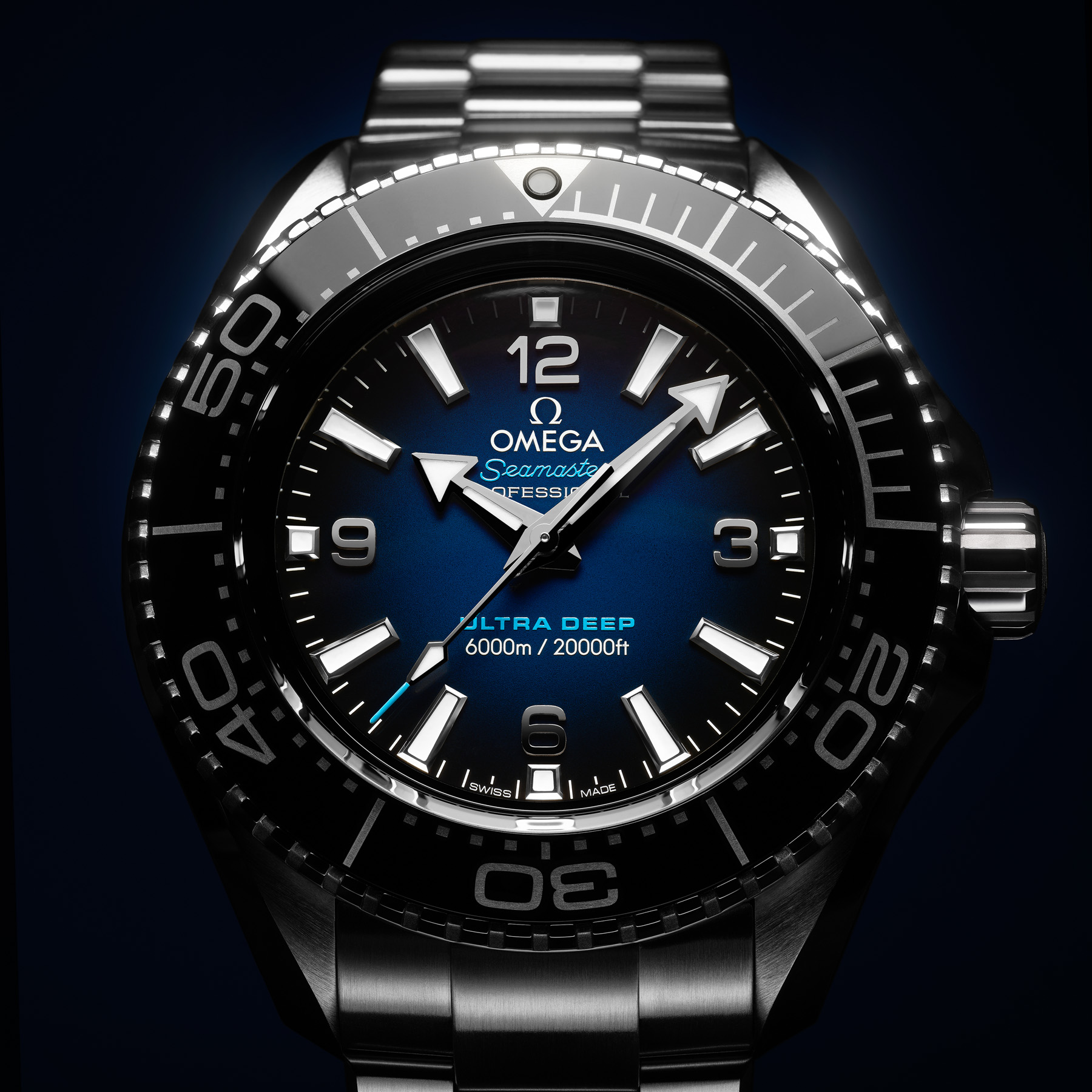 Speaking of stainless steel, while Grade 5 titanium was carried over from the prototype, Omega had to develop a new stainless steel that could achieve similar levels of hardness while maintaining the same degree of water resistance to 600 crushing atmospheres. Call O-MEGA Steel, the new alloy was tuned for its hardness, shine, and lasting lustre. And while the steel counterpart will come at a relatively modest reduction in retail price, Omega’s comparably-sized 45mm Planet Ocean Chronograph on a full steel bracelet tips the scales at a hefty 260 grams or more (depending on how many links you remove), so it’s “in for a penny, in for a pound,” right?
Speaking of stainless steel, while Grade 5 titanium was carried over from the prototype, Omega had to develop a new stainless steel that could achieve similar levels of hardness while maintaining the same degree of water resistance to 600 crushing atmospheres. Call O-MEGA Steel, the new alloy was tuned for its hardness, shine, and lasting lustre. And while the steel counterpart will come at a relatively modest reduction in retail price, Omega’s comparably-sized 45mm Planet Ocean Chronograph on a full steel bracelet tips the scales at a hefty 260 grams or more (depending on how many links you remove), so it’s “in for a penny, in for a pound,” right?
Powering the new Ultra Deep collection is the same movement that was fitted to the prototype: Omega’s Master Chronometer-certified Calibre 8912, which is consequently the same no-date automatic movement currently deployed in the Seamaster Ploprof, where you’ll note 60 hours of power reserve and that handy quick-adjust hour hand, which is great for jumping dive sites between time zones. Unlike the aforementioned Ploprof though, the movement is not visible through the Ultra Deep’s solid engraved caseback.
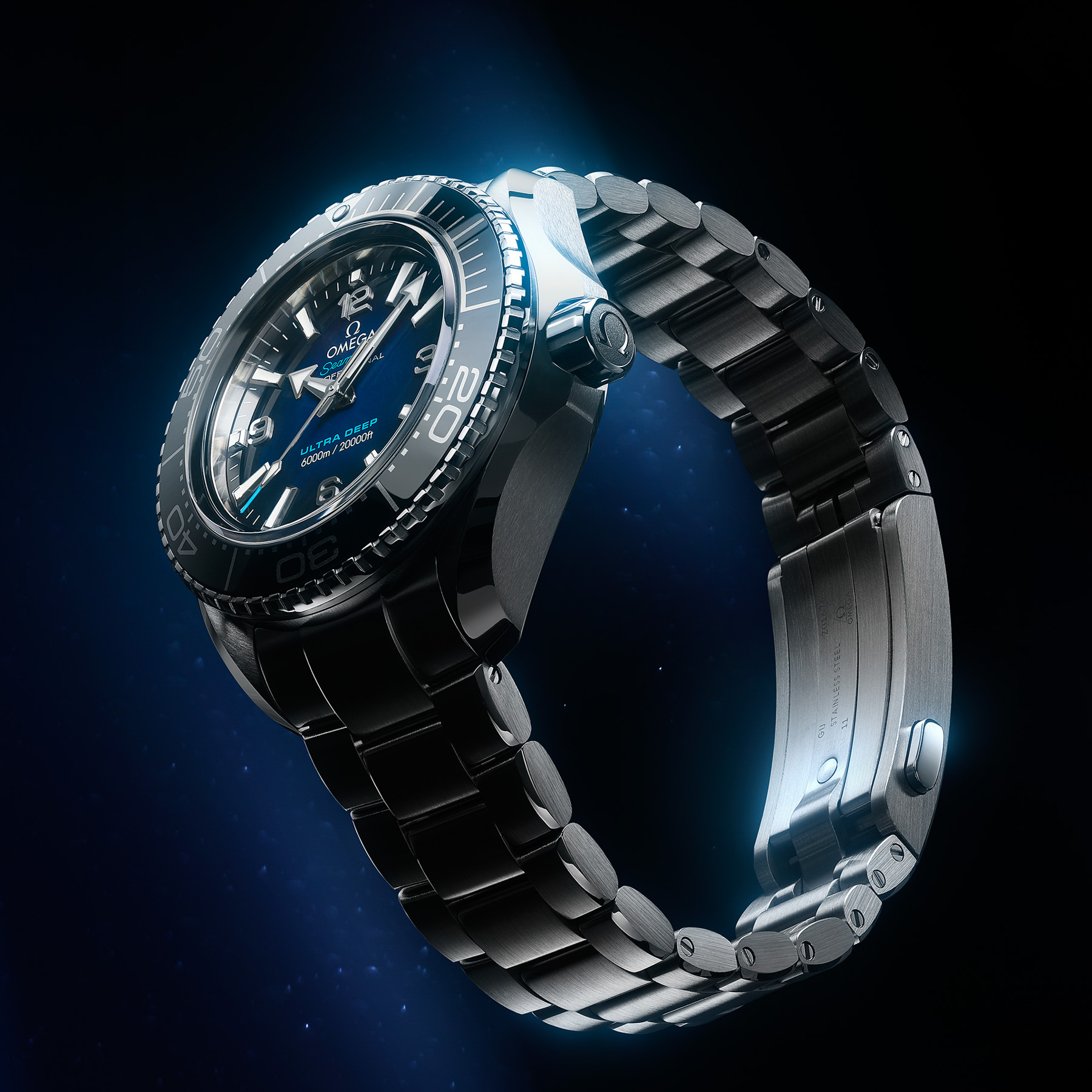 Before we get into the nitty-gritty of our full hands-on impressions of the new Ultra Deep collection, this release does provoke the question: why? Specifically, for those pining for a return to the nostalgia of the svelte Cal. 2500 Planet Ocean, why hasn’t Omega made a smaller, thinner Planet Ocean? The last visual iterative to the line came way back in 2015 (don’t miss Bilal’s exhaustive deep dive into the history of the PO right here), so by historical precedent, we’re certainly overdue. But the Ultra Deep seems to swim in the opposite direction of many a collector’s expectations for this release — specifically for those following the brand’s teaser campaign for this very launch. I think the answer is relatively simple: the Planet Ocean is not Omega’s everyday sport diver line — we have the Seamaster 300M Diver to fulfill those duties. Instead, the PO has evolved into a skunkworks platform of sorts, where Omega’s long traditions of tinkering are maintained. It’s here where new technologies (Liquid Metal) and case compositions (Deep Black) are tested, records are broken (Ultra Deep), and the R&D bar gets raised just a little further with each new release. And even as this stubbornly nostalgic Cal. 2500 Planet Ocean fan can still attest, I love it. I love all of it.
Before we get into the nitty-gritty of our full hands-on impressions of the new Ultra Deep collection, this release does provoke the question: why? Specifically, for those pining for a return to the nostalgia of the svelte Cal. 2500 Planet Ocean, why hasn’t Omega made a smaller, thinner Planet Ocean? The last visual iterative to the line came way back in 2015 (don’t miss Bilal’s exhaustive deep dive into the history of the PO right here), so by historical precedent, we’re certainly overdue. But the Ultra Deep seems to swim in the opposite direction of many a collector’s expectations for this release — specifically for those following the brand’s teaser campaign for this very launch. I think the answer is relatively simple: the Planet Ocean is not Omega’s everyday sport diver line — we have the Seamaster 300M Diver to fulfill those duties. Instead, the PO has evolved into a skunkworks platform of sorts, where Omega’s long traditions of tinkering are maintained. It’s here where new technologies (Liquid Metal) and case compositions (Deep Black) are tested, records are broken (Ultra Deep), and the R&D bar gets raised just a little further with each new release. And even as this stubbornly nostalgic Cal. 2500 Planet Ocean fan can still attest, I love it. I love all of it.
Pricing for the Omega Seamaster Planet Ocean 6000M Ultra Deep collection starts at $11,200 USD for the stainless steel variants on rubber strap and jumps to $12,300 USD for the titanium reference. You can explore the full Ultra Deep collection from omegawatches.com.
